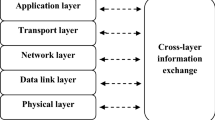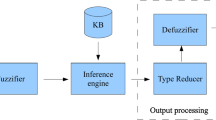Abstract
This paper demonstrates the Fuzzy and Artificial Bee Colony Based Implementation of MAC, Clustering, Routing and Data delivery by Cross-Layer approach in WSN (FABC-MACRD). The protocols of cross layer mechanism links of both the media accessibility and the energy proficient hierarchical based cluster routing. Thus for the selection of nodes the approach makes use of the fuzzy dependent CH selection technique. The major problem with hierarchical dependent clustering methodology is the congestion occurrence in CHs which are nearer to MS. This congestion generates the coverage problems as well as the network connectivity issues. Thus to rectify this issues the proposed FABC-MACRD approach combines of the network into non-similar clusters. The proposed approach utilizes the ABC optimization algorithm thus for the energy efficient and flexible transmission of data onto the Master Station, also performs the inter cluster routing commencing from CHs over the Master Station. The proposed methodology mainly includes three phases namely network association, nearest node detection phase and consistent-state stride. The performance analysis is carried out with different methodologies such as “UCR”, “ULCA”, “EAUCF” and with “IFUC”. After analysis our proposed FABC-MACRD approach shows better outcomes in terms of packet delivery, energy consumption and lifespan of the network.













Similar content being viewed by others
References
Yick, J., Mukherjee, B., & Ghosal, D. (2008). Wireless sensor network survey. Journal on Computer networks, 52(12), 2292–2330.
Gajjar, S. H., Pradhan, S. N., & Dasgupta, K. S. (2011). Wireless sensor network: application led research perspective. In Recent advances in intelligent computational systems (RAICS) (pp. 025–030), IEEE.
Rault, T., Bouabdallah, A., & Challal, Y. (2007). Energy efficiency in wireless sensor networks: A top-down survey. Journal on Computer Networks, 67, 104–122.
Wang, F., & Liu, J. (2011). Networked wireless sensor data collection: Issues, challenges, and approaches. IEEE Communications Surveys & Tutorials, 13(4), 673–687.
Gajjar, S., Choksi, N., Sarkar, M., & Dasgupta, K. (2014). Comparative analysis of wireless sensor network motes. In Signal processing and integrated networks (SPIN) (pp. 426–431), IEEE.
Gong, W., Yang, X., Zhang, M., & Long, K. (2015). An adaptive path selection model for WSN multipath routing inspired by metabolism behaviors. Science China Information Sciences, 58(10), 1–15.
Venayagamoorthy, G. K. K. (2009). A successful interdisciplinary course on computational intelligence. IEEE Computational Intelligence Magazine, 4(1), 14–23.
Chen, G., Li, C., Ye, M., & Jie, W. (2009). An unequal cluster-based routing protocol in wireless sensor networks. Journal on Wireless Networks, 15(2), 193–207.
Zhao, X., & Wang, N. (2014). An unequal layered clustering approach for large scale wireless sensor networks. International Journal on Future Computer and Communication, 1(2), 750–756.
Ranjan, R., & Varma, S. (2015). Challenges and implementation on cross layer design for wireless sensor networks. Wireless Personal Communications, 86(2), 1037–1060.
Jia, D., Li, M., Zhu, H., & Zhang, B. (2016). Layer-cluster topology sensor node deployment for large-scale multi-nodes of WSN. Wireless Personal Communications, 94(4), 3035–3056.
Rawat, P., Singh, K. D., Chaouchi, H., & Bonnin, J. M. (2014). Wireless sensor networks: a survey on recent developments and potential synergies. The Journal of supercomputing, 68(1), 1–48.
Thangaraj, M., & Anuradha, S. (2016). Energy conscious deterministic self-healing new generation wireless sensor network: smart WSN using the Aatral framework. Journal of Wireless Networks, 23(4), 1267–1284.
Kumar, N., Ghanshyam, C., & Sharma, A. K. (2015). Effect of multi-path fading model on T-ANT clustering protocol for WSN. Journal of Wireless Networks, 21(4), 1155–1162.
Bagci, H., & Yazici, A. (2013). An energy aware fuzzy approach to unequal clustering in wireless sensor networks. Elsevier Journal of Applied Soft Computing, 13(4), 1741–1749.
Ebrahimnejad, A., Tavana, M., & Alrezaamiri, H. (2016). A novel artificial bee colony algorithm for shortest path problems with fuzzy arc weights. Measurement, 93, 48–56.
Hashim, H. A., Ayinde, B. O., & Abido, M. A. (2014). Optimal placement of relay nodes in wireless sensor network using artificial bee colony algorithm. Journal of Network and Computer Applications, 64, 239–248.
Karaboga, D., Gorkemli, B., Ozturk, C., & Karaboga, N. (2014). A comprehensive survey: artificial bee colony (ABC) algorithm and applications. Journal of Artificial Intelligence, 42(1), 21–57.
Sundararaj, V. (2016). An efficient threshold prediction scheme for wavelet based ECG signal noise reduction using variable step size firefly algorithm. International Journal of Intelligent Engineering and Systems, 9(3), 117–126.
Singh, R., & Verma, A. K. (2017). Energy efficient cross layer based adaptive threshold routing protocol for WSN. AEU-International Journal of Electronics and Communications, 72, 166–173.
Xenakis, A., Foukalas, F., & Stamoulis, G. (2016). Cross-layer energy-aware topology control through simulated annealing for WSNs. Journal of Computers & Electrical Engineering, 56, 576–590.
Gokturk, M. S., Gurbuz, O., & Erman, M. (2016). A practical cross layer cooperative MAC framework for WSNS. Journal of Computer Networks, 98, 57–71.
Bagaa, M., Younis, M., Derhab, A., & Badache, N. (2014). Intertwined path formation and MAC scheduling for fast delivery of aggregated data in WSN. Journal on Computer Networks, 75, 331–350.
Mao, S., Zhao, C., Zhou, Z., & Ye, Y. (2015). An improved fuzzy unequal clustering algorithm for wireless sensor network. Springer Journal of Mobile Network Application, 18(2), 206–214.
Marappan, P., & Rodrigues, P. (2016). An energy efficient routing protocol for correlated data using CL-LEACH in WSN. Journal of Wireless Networks, 22(4), 1415–1423.
Sasikala, T., Bhagyaveni, M. A., & Jawahar Senthil Kumar, V. (2016). Cross layered adaptive rate optimised error control coding for WSN. Journal of Wireless Networks, 22(6), 2071–2079.
Author information
Authors and Affiliations
Corresponding author
Additional information
Publisher's Note
Springer Nature remains neutral with regard to jurisdictional claims in published maps and institutional affiliations.
Rights and permissions
About this article
Cite this article
Kalaikumar, K., Baburaj, E. FABC-MACRD: Fuzzy and Artificial Bee Colony Based Implementation of MAC, Clustering, Routing and Data Delivery by Cross-Layer Approach in WSN. Wireless Pers Commun 103, 1633–1655 (2018). https://doi.org/10.1007/s11277-018-5872-5
Published:
Issue Date:
DOI: https://doi.org/10.1007/s11277-018-5872-5




